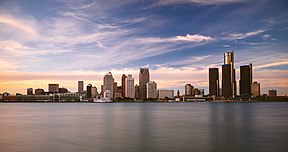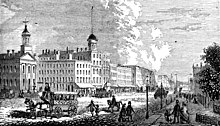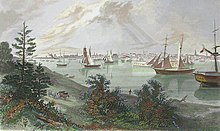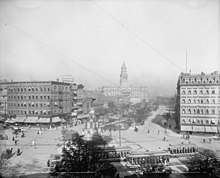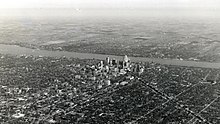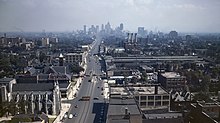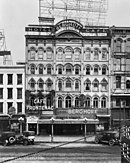
A | B | C | D | E | F | G | H | CH | I | J | K | L | M | N | O | P | Q | R | S | T | U | V | W | X | Y | Z | 0 | 1 | 2 | 3 | 4 | 5 | 6 | 7 | 8 | 9
Detroit | |
|---|---|
|
| |
| Etymology: French: détroit (strait) | |
| Nicknames: The Motor City, Motown, The D, 313, D-Town, Renaissance City, The Town That Put The World on Wheels, Hockeytown, Detroit Rock City | |
| Motto(s): Speramus Meliora; Resurget Cineribus (Latin: We Hope For Better Things; It Shall Rise From the Ashes) | |
| Coordinates: 42°19′53″N 83°02′45″W / 42.33139°N 83.04583°W[1] | |
| Country | United States |
| State | Michigan |
| County | Wayne |
| Founded | July 24, 1701 |
| Incorporated | September 13, 1806 |
| Founded by | Antoine de la Mothe Cadillac & Alphonse de Tonty |
| Government | |
| • Type | Strong Mayor |
| • Body | Detroit City Council |
| • Mayor | Mike Duggan (D) |
| • Clerk | Janice Winfrey |
| • City council | Members
|
| Area | |
| • City | 142.89 sq mi (370.09 km2) |
| • Land | 138.73 sq mi (359.31 km2) |
| • Water | 4.16 sq mi (10.78 km2) |
| • Urban | 1,284.8 sq mi (3,327.7 km2) |
| • Metro | 3,888.4 sq mi (10,071 km2) |
| Elevation | 656 ft (200 m) |
| Population | |
| • City | 639,111 |
| • Estimate (2021)[3] | 632,464 |
| • Rank | 63rd in North America 27th in the United States 1st in Michigan |
| • Density | 4,606.84/sq mi (1,778.71/km2) |
| • Urban | 3,776,890 (US: 12th) |
| • Urban density | 2,939.6/sq mi (1,135.0/km2) |
| • Metro | 4,365,205 (US: 14th) |
| Demonym | Detroiter |
| GDP | |
| • MSA | $305.412 billion (2022) |
| Time zone | UTC−5 (EST) |
| • Summer (DST) | UTC−4 (EDT) |
| ZIP Codes | 482XX |
| Area code | 313 |
| FIPS code | 26-22000 |
| GNIS feature ID | 1617959[1] |
| Major airports | Detroit Metropolitan Airport, Coleman A. Young International Airport |
| Mass transit | Detroit Department of Transportation, Detroit People Mover, QLine |
| Website | detroitmi |
Detroit (/dɪˈtrɔɪt/; dih-TROYT, locally also /ˈdiːtrɔɪt/)[7] is the most populous city in the U.S. state of Michigan. It is the largest U.S. city on the United States–Canada border, and the seat of government of Wayne County. Detroit had a population of 639,111 at the 2020 census,[8] making it the 29th-most populous city in the United States. The Metro Detroit area, home to 4.3 million people, is the second-largest in the Midwest after the Chicago metropolitan area and the 14th-largest in the United States. A significant cultural center, Detroit is known for its contributions to music, art, architecture and design, in addition to its historical automotive background.[9][10]
In 1701, Antoine de la Mothe Cadillac and Alphonse de Tonty founded Fort Pontchartrain du Détroit. During the late 19th and early 20th century, it became an important industrial hub at the center of the Great Lakes region. The city's population rose to be the fourth-largest in the nation by 1920, after New York City, Chicago and Philadelphia, with the expansion of the automotive industry in the early 20th century.[11] The Detroit River became the busiest commercial hub in the world as it carried over 65 million tons of shipping commerce each year. In the mid-20th century, Detroit entered a state of urban decay which has continued to the present, as a result of industrial restructuring, the loss of jobs in the auto industry, and rapid suburbanization. Since reaching a peak of 1.85 million at the 1950 census, Detroit's population has declined by more than 65 percent.[8] In 2013, Detroit became the largest U.S. city to file for bankruptcy, which it successfully exited in December 2014.[12]
Detroit is a port on the Detroit River, one of the four major straits that connect the Great Lakes system to the St. Lawrence Seaway. The city anchors the second-largest regional economy in the Midwest and the 14th-largest in the United States.[13] Detroit is best known as the center of the U.S. automotive industry, and the "Big Three" auto manufacturers—General Motors, Ford, and Stellantis North America (Chrysler)—are all headquartered in Metro Detroit.[14] The Detroit Metropolitan Airport is among the most important hub airports in the United States. Detroit and its neighboring Canadian city Windsor constitute the second-busiest international crossing in North America, after San Diego–Tijuana.[15]
Detroit's diverse culture has had both local and international influence, particularly in music, with the city giving rise to the genres of Motown and techno and playing an important role in the development of jazz, hip-hop, rock, and punk. The rapid growth of Detroit in its boom years resulted in a globally unique stock of architectural monuments and historic places. Since the 2000s, conservation efforts have managed to save many architectural pieces and achieve several large-scale revitalizations, including the restoration of several historic theaters and entertainment venues, high-rise renovations, new sports stadiums, and a riverfront revitalization project.
An increasingly popular tourist destination, Detroit receives 16 million visitors per year.[16] In 2015, Detroit was named a "City of Design" by UNESCO, the first U.S. city to receive that designation.[17] Time named Detroit as one of the fifty World's Greatest Places of 2022 to explore.[18]
History
Toponymy

Detroit is named after the Detroit River, connecting Lake Huron with Lake Erie. The name comes from the French word détroit meaning 'strait' as the city was situated on a narrow passage of water linking the two lakes. The river was known as le détroit du Lac Érié in French, which means 'the strait of Lake Erie'.[19][20] In the historical context, the strait included the St. Clair River, Lake St. Clair and the Detroit River.[21][22]
Early settlement
Kingdom of France 1701–1760
Kingdom of Great Britain 1760–1783
United States 1783-1812
United Kingdom 1812–1813
United States 1813–present
Paleo-Indians inhabited areas near Detroit as early as 11,000 years ago including the culture referred to as the Mound Builders.[23] By the 17th century, the region was inhabited by Huron, Odawa, Potawatomi and Iroquois peoples.[24] The area is known by the Anishinaabe people as Waawiiyaataanong, translating to 'where the water curves around'.[25]
The first Europeans did not penetrate into the region and reach the straits of Detroit until French missionaries and traders worked their way around the Iroquois League, with whom they were at war in the 1630s.[26] The Huron and Neutral people held the north side of Lake Erie until the 1650s, when the Iroquois pushed them and the Erie people away from the lake and its beaver-rich feeder streams in the Beaver Wars of 1649–1655.[26] By the 1670s, the war-weakened Iroquois laid claim to as far south as the Ohio River valley in northern Kentucky as hunting grounds,[26] and had absorbed many other Iroquoian peoples after defeating them in war.[26] For the next hundred years, virtually no British or French action was contemplated without consultation with the Iroquois or consideration of their likely response.[26] When the French and Indian War evicted the Kingdom of France from Canada, it removed one barrier to American colonists migrating west.[27]
British negotiations with the Iroquois would both prove critical and lead to a Crown policy limiting settlements below the Great Lakes and west of the Alleghenies. Many colonial American would-be migrants resented this restraint and became supporters of the American Revolution. The 1778 raids and resultant 1779 decisive Sullivan Expedition reopened the Ohio Country to westward emigration, which began almost immediately. By 1800 white settlers were pouring westwards.[28]
French settlement

On July 24, 1701, the French explorer Antoine de la Mothe Cadillac, with his lieutenant Alphonse de Tonty and more than a hundred other settlers, began constructing a small fort on the north bank of the Detroit River. Cadillac named the settlement Fort Pontchartrain du Détroit,[29] after Louis Phélypeaux, comte de Pontchartrain, Secretary of State of the Navy under Louis XIV.[30] Sainte-Anne-de-Détroit was founded on July 26 and is the second-oldest continuously operating Roman Catholic parish in the United States.[31] France offered free land to colonists to attract families to Detroit; when it reached a population of 800 in 1765, it became the largest European settlement between Montreal and New Orleans, both also French settlements, in the former colonies of New France and La Louisiane, respectively.[32]
By 1773, after the addition of Anglo-American settlers, the population of Detroit was 1,400. By 1778, its population reached 2,144 and it was the third-largest city in what was known as the Province of Quebec since the British takeover of French colonies following their victory in the Seven Years' War.[33]
The region's economy was based on the lucrative fur trade, in which numerous Native American people had important roles as trappers and traders. Today the flag of Detroit reflects its French colonial heritage. Descendants of the earliest French and French-Canadian settlers formed a cohesive community, who gradually were superseded as the dominant population after more Anglo-American settlers arrived in the early 19th century with American westward migration. Living along the shores of Lake St. Clair and south to Monroe and downriver suburbs, the ethnic French Canadians of Detroit, also known as Muskrat French in reference to the fur trade, remain a subculture in the region in the 21st century.[34][35]
During the French and Indian War (1754–63)—the North American front of the Seven Years' War between Britain and France—British troops gained control of the settlement in 1760 and shortened its name to Detroit. Several regional Native American tribes, such as the Potowatomi, Ojibwe and Huron, launched Pontiac's War in 1763 and laid siege to Fort Detroit but failed to capture it. In defeat, France ceded its territory in North America east of the Mississippi to Britain following the war.[36]
Following the American Revolutionary War and the establishment of the United States as an independent country, Britain ceded Detroit along with other territories in the area under the Jay Treaty which established the northern border with its colony of Canada.[37] The Great Fire of 1805 destroyed most of the Detroit settlement, which had primarily buildings made of wood. One stone fort, a river warehouse, and brick chimneys of former wooden homes were the sole structures to survive.[38] Of the 600 Detroit residents in this area, none died in the fire.[39]
19th century
From 1805 to 1847, Detroit was the capital of Michigan as a territory and as a state. William Hull, the United States commander at Detroit, surrendered without a fight to British troops and their Native American allies during the War of 1812 in the siege of Detroit, believing his forces were vastly outnumbered. The Battle of Frenchtown was part of a U.S. effort to retake the city, and U.S. troops suffered their highest fatalities of any battle in the war. This battle is commemorated at River Raisin National Battlefield Park south of Detroit in Monroe County. Detroit was recaptured by the United States later that year.[40]
The settlement was incorporated as a city in 1815.[41] As the city expanded, a radial geometric street plan developed by Chief Justice Augustus B. Woodward was followed, featuring grand boulevards as in Paris.[42] In 1817, Woodward went on to establish the Catholepistemiad, or University of Michigania in the city. Intended to be a centralized system of schools, libraries, and other cultural and scientific institutions for the Michigan Territory, the Catholepistemiad evolved into the modern University of Michigan.
Prior to the American Civil War, the city's access to the Canada–US border made it a key stop for refugee slaves gaining freedom in the North along the Underground Railroad. Many went across the Detroit River to Canada to escape pursuit by slave catchers.[43][41] An estimated 20,000 to 30,000 African-American refugees settled in Canada.[44] George DeBaptiste was considered to be the "president" of the Detroit Underground Railroad, William Lambert the "vice president" or "secretary", and Laura Smith Haviland the "superintendent".[45]
Numerous men from Detroit volunteered to fight for the Union during the Civil War, including the 24th Michigan Infantry Regiment. It was part of the Iron Brigade, which fought with distinction and suffered 82% casualties at the Battle of Gettysburg in 1863. When the First Volunteer Infantry Regiment arrived to fortify Washington, D.C., President Abraham Lincoln is quoted as saying, "Thank God for Michigan!" George Armstrong Custer led the Michigan Brigade during the Civil War and called them the "Wolverines".[46]
During the late 19th century, wealthy industry and shipping magnates commissioned the design and construction of several Gilded Age mansions east and west of the current downtown, along the major avenues of the Woodward plan. Most notable among them was the David Whitney House at 4421 Woodward Avenue, and the grand avenue became a favored address for mansions. During this period, some referred to Detroit as the "Paris of the West" for its architecture, grand avenues in the Paris style, and for Washington Boulevard, recently electrified by Thomas Edison.[41] The city had grown steadily from the 1830s with the rise of shipping, shipbuilding, and manufacturing industries. Strategically located along the Great Lakes waterway, Detroit emerged as a major port and transportation hub. [citation needed]
In 1896, a thriving carriage trade prompted Henry Ford to build his first automobile in a rented workshop on Mack Avenue. During this growth period, Detroit expanded its borders by annexing all or part of several surrounding villages and townships.[47]
20th century
In 1903, Henry Ford founded the Ford Motor Company. Ford's manufacturing—and those of automotive pioneers William C. Durant, Horace and John Dodge, James and William Packard, and Walter Chrysler—established Detroit's status in the early 20th century as the world's automotive capital.[41] The growth of the auto industry was reflected by changes in businesses throughout the Midwest and nation, with the development of garages to service vehicles and gas stations, as well as factories for parts and tires.[citation needed] Because of the booming auto industry, Detroit became the fourth-largest city in the nation by 1920, following New York City, Chicago and Philadelphia.[48]
In 1907, the Detroit River carried 67,292,504 tons of shipping commerce through Detroit to locations all over the world. For comparison, London shipped 18,727,230 tons, and New York shipped 20,390,953 tons. The river was dubbed "the Greatest Commercial Artery on Earth" by The Detroit News in 1908. The prohibition of alcohol from 1920 to 1933 resulted in the Detroit River becoming a major conduit for smuggling of illegal Canadian spirits.[11]
With the rapid growth of industrial workers in the auto factories, labor unions such as the American Federation of Labor and the United Auto Workers (UAW) fought to organize workers to gain them better working conditions and wages. They initiated strikes and other tactics in support of improvements such as the 8-hour day/40-hour work week, increased wages, greater benefits, and improved working conditions. The labor activism during those years increased the influence of union leaders in the city such as Jimmy Hoffa of the Teamsters and Walter Reuther of the UAW.[49]
Detroit, like many places in the United States, developed racial conflict and discrimination in the 20th century following the rapid demographic changes as hundreds of thousands of new workers were attracted to the industrial city. The Great Migration brought rural blacks from the South; they were outnumbered by southern whites who also migrated to the city. Immigration brought southern and eastern Europeans of Catholic and Jewish faith; these new groups competed with native-born whites for jobs and housing in the booming city.[citation needed]
Detroit was one of the major Midwest cities that was a site for the dramatic urban revival of the Ku Klux Klan (KKK) beginning in 1915. "By the 1920s the city had become a stronghold of the KKK", whose members primarily opposed Catholic and Jewish immigrants but also practiced discrimination against Black Americans.[50] Even after the decline of the KKK in the late 1920s, the Black Legion, a secret vigilante group, was active in the Detroit area in the 1930s. One-third of its estimated 20,000 to 30,000 members in Michigan were based in the city. It was defeated after numerous prosecutions following the kidnapping and murder in 1936 of Charles Poole, a Catholic organizer with the federal Works Progress Administration. Some 49 men of the Black Legion were convicted of numerous crimes, with many sentenced to life in prison for murder.[51]
By 1940, 80% of Detroit deeds contained restrictive covenants prohibiting African Americans from buying houses they could afford. These discriminatory tactics were successful as a majority of black people in Detroit resorted to living in all-black neighborhoods such as Black Bottom and Paradise Valley. At this time, white people still made up about 90.4% of the city's population.[52] White residents attacked black homes: breaking windows, starting fires, and detonating bombs.[53][54]
In the 1940s the world's "first urban depressed freeway" ever built, the Davison,[55] was constructed. During World War II, the government encouraged retooling of the American automobile industry in support of the Allied powers, leading to Detroit's key role in the American Arsenal of Democracy.[56] Jobs expanded so rapidly due to the defense buildup in World War II that 400,000 people migrated to the city from 1941 to 1943, including 50,000 blacks in the second wave of the Great Migration, and 350,000 whites, many of them from the South. Whites, including ethnic Europeans, feared black competition for jobs and scarce housing. The federal government prohibited discrimination in defense work, but when in June 1943 Packard promoted three black people to work next to whites on its assembly lines, 25,000 white workers walked off the job.[57] The 1943 Detroit race riot took place in June, three weeks after the Packard plant protest, beginning with an altercation at Belle Isle. A total of 34 people were killed, 25 of them black and most at the hands of the white police force, while 433 were wounded (75% of them black), and property valued at $2 million (worth $30.4 million in 2020) was destroyed. Rioters moved through the city, and young whites traveled across town to attack more settled blacks in their neighborhood of Paradise Valley.[58][59]
Postwar era
Industrial mergers in the 1950s, especially in the automobile sector, increased oligopoly in the American auto industry. Detroit manufacturers such as Packard and Hudson merged into other companies and eventually disappeared. At its peak population of 1,849,568, in the 1950 Census, the city was the fifth-largest in the United States.[60]
In this postwar era, the auto industry continued to create opportunities for many African Americans from the South, who continued with their Great Migration to Detroit and other northern and western cities to escape the strict Jim Crow laws and racial discrimination policies of the South. Postwar Detroit was a prosperous industrial center of mass production. The auto industry comprised about 60% of all industry in the city, allowing space for a plethora of separate booming businesses including stove making, brewing, furniture building, oil refineries, pharmaceutical manufacturing, and more. The expansion of jobs created unique opportunities for black Americans, who saw novel high employment rates: there was a 103% increase in the number of blacks employed in postwar Detroit. Black Americans who immigrated to northern industrial cities from the south still faced intense racial discrimination in the employment sector. Racial discrimination kept the workforce and better jobs predominantly white, while many black Detroiters held lower-paying factory jobs. Despite changes in demographics as the city's black population expanded, Detroit's police force, fire department, and other city jobs continued to be held by predominantly white residents. This created an unbalanced racial power dynamic.[61]
Unequal opportunities in employment resulted in unequal housing opportunities for the majority of the black community: with overall lower incomes and facing the backlash of discriminatory housing policies, the black community was limited to lower cost, lower quality housing in the city. The surge in the black population augmented the strain on housing scarcity. The livable areas available to the black community were limited, and as a result, families often crowded together in unsanitary, unsafe, and illegal quarters. Such discrimination became increasingly evident in the policies of redlining implemented by banks and federal housing groups, which almost completely restricted the ability of blacks to improve their housing and encouraged white people to guard the racial divide that defined their neighborhoods. As a result, black people were often denied bank loans to obtain better housing, and interest rates and rents were unfairly inflated to prevent their moving into white neighborhoods. White residents and political leaders largely opposed the influx of black Detroiters to white neighborhoods, believing that their presence would lead to neighborhood deterioration. This perpetuated a cyclical exclusionary process that marginalized the agency of black Detroiters by trapping them in the unhealthiest, least safe areas of the city.[61]
As in other major American cities in the postwar era, modernist planning ideology drove the construction of a federally subsidized, extensive highway and freeway system around Detroit, and pent-up demand for new housing stimulated suburbanization; highways made commuting by car for higher-income residents easier. However, this construction had negative implications for many lower-income urban residents. Highways were constructed through and completely demolished neighborhoods of poor residents and black communities who had less political power to oppose them. The neighborhoods were mostly low income, considered blighted, or made up of older housing where investment had been lacking due to racial redlining, so the highways were presented as a kind of urban renewal. These neighborhoods (such as Black Bottom and Paradise Valley) were extremely important to the black communities of Detroit, providing spaces for independent black businesses and social/cultural organizations. Their destruction displaced residents with little consideration of the effects of breaking up functioning neighborhoods and businesses.[61]
In 1956, Detroit's last heavily used electric streetcar line, which traveled along the length of Woodward Avenue, was removed and replaced with gas-powered buses. It was the last line of what had once been a 534-mile network of electric streetcars. In 1941, at peak times, a streetcar ran on Woodward Avenue every 60 seconds.[62][63]
All of these changes in the area's transportation system favored low-density, auto-oriented development rather than high-density urban development. Industry also moved to the suburbs, seeking large plots of land for single-story factories. By the 21st century, the metro Detroit area had developed as one of the most sprawling job markets in the United States; combined with poor public transport, this resulted in many new jobs being beyond the reach of urban low-income workers.[64]
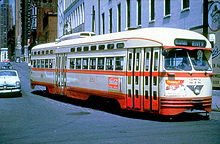
In 1950, the city held about one-third of the state's population. Over the next 60 years, the city's population declined to less than 10 percent of the state's population. During the same time period, the sprawling metropolitan area grew to contain more than half of Michigan's population.[41] The shift of population and jobs eroded Detroit's tax base.[citation needed]
In June 1963, Rev. Martin Luther King Jr. gave a major speech as part of a civil rights march in Detroit that foreshadowed his "I Have a Dream" speech in Washington, D.C., two months later. While the civil rights movement gained significant federal civil rights laws in 1964 and 1965, longstanding inequities resulted in confrontations between the police and inner-city black youth who wanted change.[65]
I have a dream this afternoon that my four little children, that my four little children will not come up in the same young days that I came up within, but they will be judged on the basis of the content of their character, not the color of their skin ... I have a dream this evening that one day we will recognize the words of Jefferson that "all men are created equal, that they are endowed by their Creator with certain unalienable Rights, that among these are Life, Liberty and the pursuit of Happiness." I have a dream ...
—Martin Luther King Jr. (June 1963 Speech at the Great March on Detroit)[66]
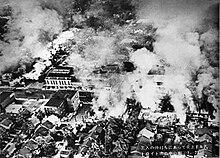
Longstanding tensions in Detroit culminated in the Twelfth Street riot in July 1967. Governor George W. Romney ordered the Michigan National Guard into Detroit, and President Lyndon B. Johnson sent in U.S. Army troops. The result was 43 dead, 467 injured, over 7,200 arrests, and more than 2,000 buildings destroyed, mostly in black residential and business areas. Thousands of small businesses closed permanently or relocated to safer neighborhoods. The affected district lay in ruins for decades.[67] According to the Chicago Tribune, it was the 3rd most costly riot in the United States.[68]
On August 18, 1970, the NAACP filed suit against Michigan state officials, including Governor William Milliken, charging de facto public school segregation. The NAACP argued that although schools were not legally segregated, the city of Detroit and its surrounding counties had enacted policies to maintain racial segregation in public schools. The NAACP also suggested a direct relationship between unfair housing practices and educational segregation, as the composition of students in the schools followed segregated neighborhoods.[69] The District Court held all levels of government accountable for the segregation in its ruling. The Sixth Circuit Court of Appeals affirmed some of the decision, holding that it was the state's responsibility to integrate across the segregated metropolitan area.[70] The U.S. Supreme Court took up the case February 27, 1974.[69] The subsequent Milliken v. Bradley decision had nationwide influence. In a narrow decision, the Supreme Court found schools were a subject of local control, and suburbs could not be forced to aid with the desegregation of the city's school district.[71]
"Milliken was perhaps the greatest missed opportunity of that period", said Myron Orfield, professor of law at the University of Minnesota Law School. "Had that gone the other way, it would have opened the door to fixing nearly all of Detroit's current problems."[72] John Mogk, a professor of law and an expert in urban planning at Wayne State University Law School in Detroit, says,
Everybody thinks that it was the riots that caused the white families to leave. Some people were leaving at that time but, really, it was after Milliken that you saw mass flight to the suburbs. If the case had gone the other way, it is likely that Detroit would not have experienced the steep decline in its tax base that has occurred since then.[72]
1970s and decline
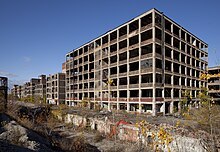
In November 1973, the city elected Coleman Young as its first black mayor. After taking office, Young emphasized increasing racial diversity in the police department, which was predominantly white.[73] Young also worked to improve Detroit's transportation system, but the tension between Young and his suburban counterparts over regional matters was problematic throughout his mayoral term.
In 1976, the federal government offered $600 million (~$2.5 billion in 2023) for building a regional rapid transit system, under a single regional authority.[74] But the inability of Detroit and its suburban neighbors to solve conflicts over transit planning resulted in the region losing the majority of funding for rapid transit.[citation needed] The city then moved forward with construction of the elevated downtown circulator portion of the system, which became known as the Detroit People Mover.[75]
The gasoline crises of 1973 and 1979 affected auto industry. Buyers chose smaller, more fuel-efficient cars made by foreign makers as the price of gas rose. Efforts to revive the city were stymied by the struggles of the auto industry, as their sales and market share declined. Automakers laid off thousands of employees and closed plants in the city, further eroding the tax base. To counteract this, the city used eminent domain to build two large new auto assembly plants in the city.[76]
Young sought to revive the city by seeking to increase investment in the city's declining downtown. The Renaissance Center, a mixed-use office and retail complex, opened in 1977. This group of skyscrapers was an attempt to keep businesses in downtown.[41][77][78] Young also gave city support to other large developments to attract middle and upper-class residents back to the city. Despite the Renaissance Center and other projects, the downtown area continued to lose businesses to the automobile-dependent suburbs. Major stores and hotels closed, and many large office buildings went vacant. Young was criticized for being too focused on downtown development and not doing enough to lower the city's high crime rate and improve city services to residents.[citation needed]
High unemployment was compounded by middle-class flight to the suburbs, and some residents leaving the state to find work. The result for the city was a higher proportion of poor in its population, reduced tax base, depressed property values, abandoned buildings, abandoned neighborhoods, and high crime rates.[79]
1980s
On August 16, 1987, Northwest Airlines Flight 255 crashed near Detroit Metro airport, killing all but one of the 155 people on board, as well as two people on the ground.[80]
1990s & 2000s
In 1993, Young retired as Detroit's longest-serving mayor, deciding not to seek a sixth term, with Dennis Archer succeeding him. Archer prioritized downtown development, easing tensions with its suburban neighbors. A referendum to allow casino gambling in the city passed in 1996; several temporary casino facilities opened in 1999, and permanent downtown casinos with hotels opened in 2007–08.[81]
Campus Martius, a reconfiguration of downtown's main intersection as a new park, was opened in 2004. The park has been cited as one of the best public spaces in the United States.[82][83][84] In 2001, the first portion of the International Riverfront redevelopment was completed as a part of the city's 300th-anniversary celebration.[85]
2010s
In September 2008, Mayor Kwame Kilpatrick (who had served for six years) resigned following felony convictions. In 2013, Kilpatrick was convicted on 24 federal felony counts, including mail fraud, wire fraud, and racketeering,[86] and was sentenced to 28 years in federal prison.[87] The former mayor's activities cost the city an estimated $20 million.[88] Roughly half of the owners of Detroit's 305,000 properties failed to pay their 2011 tax bills, resulting in about $246 million (~$329 million in 2023) in taxes and fees going uncollected, nearly half of which was due to Detroit. The rest of the money would have been earmarked for Wayne County, Detroit Public Schools, and the library system.[89]
The city's financial crisis resulted in Michigan taking over administrative control of its government.[90] Governor Rick Snyder declared a financial emergency in March 2013, stating the city had a $327 million budget deficit and faced more than $14 billion in long-term debt. It had been making ends meet on a month-to-month basis with the help of bond money held in a state escrow account and had instituted mandatory unpaid days off for many city workers. Those troubles, along with underfunded city services, such as police and fire departments, and ineffective turnaround plans from Mayor Bing and the City Council[91] led the state of Michigan to appoint an emergency manager for Detroit. On June 14, 2013, Detroit defaulted on $2.5 billion of debt by withholding $39.7 million in interest payments, while Emergency Manager Kevyn Orr met with bondholders and other creditors in an attempt to restructure the city's $18.5 billion debt and avoid bankruptcy.[92] On July 18, 2013, Detroit became the largest U.S. city to file for bankruptcy.[93] It was declared bankrupt by U.S. District Court on December 3, with its $18.5 billion debt.[94] On November 7, 2014, the city's plan for exiting bankruptcy was approved. On December 11 the city officially exited bankruptcy. The plan allowed the city to eliminate $7 billion in debt and invest $1.7 billion into improved city services.[95]
One way the city obtained this money was through the Detroit Institute of Arts (DIA). Holding over 60,000 pieces of art worth billions of dollars, some saw it as the key to funding this investment. The city came up with a plan to monetize the art and sell it, leading to the DIA becoming a private organization. After months of legal battles, the city finally got hundreds of millions of dollars towards funding a new Detroit.[96]
One of the largest post-bankruptcy efforts to improve city services has been to fix the city's broken street lighting system. At one time it was estimated that 40% of lights were not working, which resulted in public safety issues and abandonment of housing. The plan called for replacing outdated high-pressure sodium lights with 65,000 LED lights. Construction began in late 2014 and finished in December 2016; Detroit is the largest U.S. city with all LED street lighting.[97]
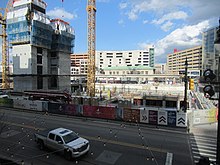
In the 2010s, several initiatives were taken by Detroit's citizens and new residents to improve the cityscape by renovating and revitalizing neighborhoods. Such projects include volunteer renovation groups[98] and various urban gardening movements.[99] Miles of associated parks and landscaping have been completed in recent years. In 2011, the Port Authority Passenger Terminal opened, with the riverwalk connecting Hart Plaza to the Renaissance Center.[78]
One symbol of the city's decades-long decline, the Michigan Central Station, was long vacant. The city renovated it with new windows, elevators and facilities, completing the work in December 2015.[100] In 2018, Ford Motor Company purchased the building and plans to use it for mobility testing with a potential return of train service.[101] Several other landmark buildings have been privately renovated and adapted as condominiums, hotels, offices, or for cultural uses. Detroit was mentioned as a city of renaissance and has reversed many of the trends of the prior decades.[102][103]
The city has seen a rise in gentrification.[104] In downtown, for example, the construction of Little Caesars Arena brought with it high class shops and restaurants along Woodward Avenue. Office tower and condominium construction has led to an influx of wealthy families but also a displacement of long-time residents and culture.[105][106] Areas outside of downtown and other recently revived areas have an average household income of about 25% less than the gentrified areas, a gap that is continuing to grow.[107] Rents and cost of living in these gentrified areas rise every year, pushing minorities and the poor out, causing more and more racial disparity and separation in the city. In 2019, the cost of a one-bedroom loft in Rivertown reached $300,000 (~$352,668 in 2023), with a five-year sale price change of over 500% and average income rising by 18%.[108]
Geography

Metropolitan area
Detroit is the center of a three-county urban area (with a population of 3,734,090 within an area of 1,337 square miles (3,460 km2) according to the 2010 United States Census), six-county metropolitan statistical area (population of 5,322,219 in an area of 3,913 square miles as of the 2010 census), and a nine-county Combined Statistical Area (population of 5.3 million within 5,814 square miles as of 2010[update]).[109][110][111]
Topography
According to the U.S. Census Bureau, the city has a total area of 142.87 square miles (370.03 km2), of which 138.75 square miles (359.36 km2) is land and 4.12 square miles (10.67 km2) is water.[112] Detroit is the principal city in Metro Detroit and Southeast Michigan. It is situated in the Midwestern United States and the Great Lakes region.[113]
The Detroit River International Wildlife Refuge is the only international wildlife preserve in North America and is uniquely located in the heart of a major metropolitan area. The refuge includes islands, coastal wetlands, marshes, shoals, and waterfront lands along 48 miles (77 km) of the Detroit River and western Lake Erie shoreline.[114]
The city slopes gently from the northwest to southeast on a till plain composed largely of glacial and lake clay. The most notable topographical feature in the city is the Detroit Moraine, a broad clay ridge on which the older portions of Detroit and Windsor are located, rising approximately 62 feet (19 m) above the river at its highest point.[115] The highest elevation in the city is directly north of Gorham Playground on the northwest side approximately three blocks south of 8 Mile Road, at a height of 675 to 680 feet (206 to 207 m).[116] Detroit's lowest elevation is along the Detroit River, at a surface height of 572 feet (174 m).[117]
Belle Isle Park is a 982-acre (1.534 sq mi; 397 ha) island park in the Detroit River, between Detroit and Windsor, Ontario. It is connected to the mainland by the MacArthur Bridge. Belle Isle Park contains such attractions as the James Scott Memorial Fountain, the Belle Isle Conservatory, the Detroit Yacht Club on an adjacent island, a half-mile (800 m) beach, a golf course, a nature center, monuments, and gardens. Both the Detroit and Windsor skylines can be viewed at the island's Sunset Point.[118]
Three road systems cross the city: the original French template, with avenues radiating from the waterfront, and true north–south roads based on the Northwest Ordinance township system. The city is north of Windsor, Ontario. Detroit is the only major city along the Canada–U.S. border in which one travels south in order to cross into Canada.[119]
Detroit has four border crossings: the Ambassador Bridge and the Detroit–Windsor tunnel provide motor vehicle thoroughfares, with the Michigan Central Railway Tunnel providing railroad access to and from Canada. The fourth border crossing is the Detroit–Windsor Truck Ferry, near the Windsor Salt Mine and Zug Island. Near Zug Island, the southwest part of the city was developed over a 1,500-acre (610 ha) salt mine that is 1,100 feet (340 m) below the surface. The Detroit salt mine run by the Detroit Salt Company has over 100 miles (160 km) of roads within.[120][121]
Climate
| Detroit, Michigan | ||||||||||||||||||||||||||||||||||||||||||||||||
|---|---|---|---|---|---|---|---|---|---|---|---|---|---|---|---|---|---|---|---|---|---|---|---|---|---|---|---|---|---|---|---|---|---|---|---|---|---|---|---|---|---|---|---|---|---|---|---|---|
| Climate chart (explanation) | ||||||||||||||||||||||||||||||||||||||||||||||||
| ||||||||||||||||||||||||||||||||||||||||||||||||

